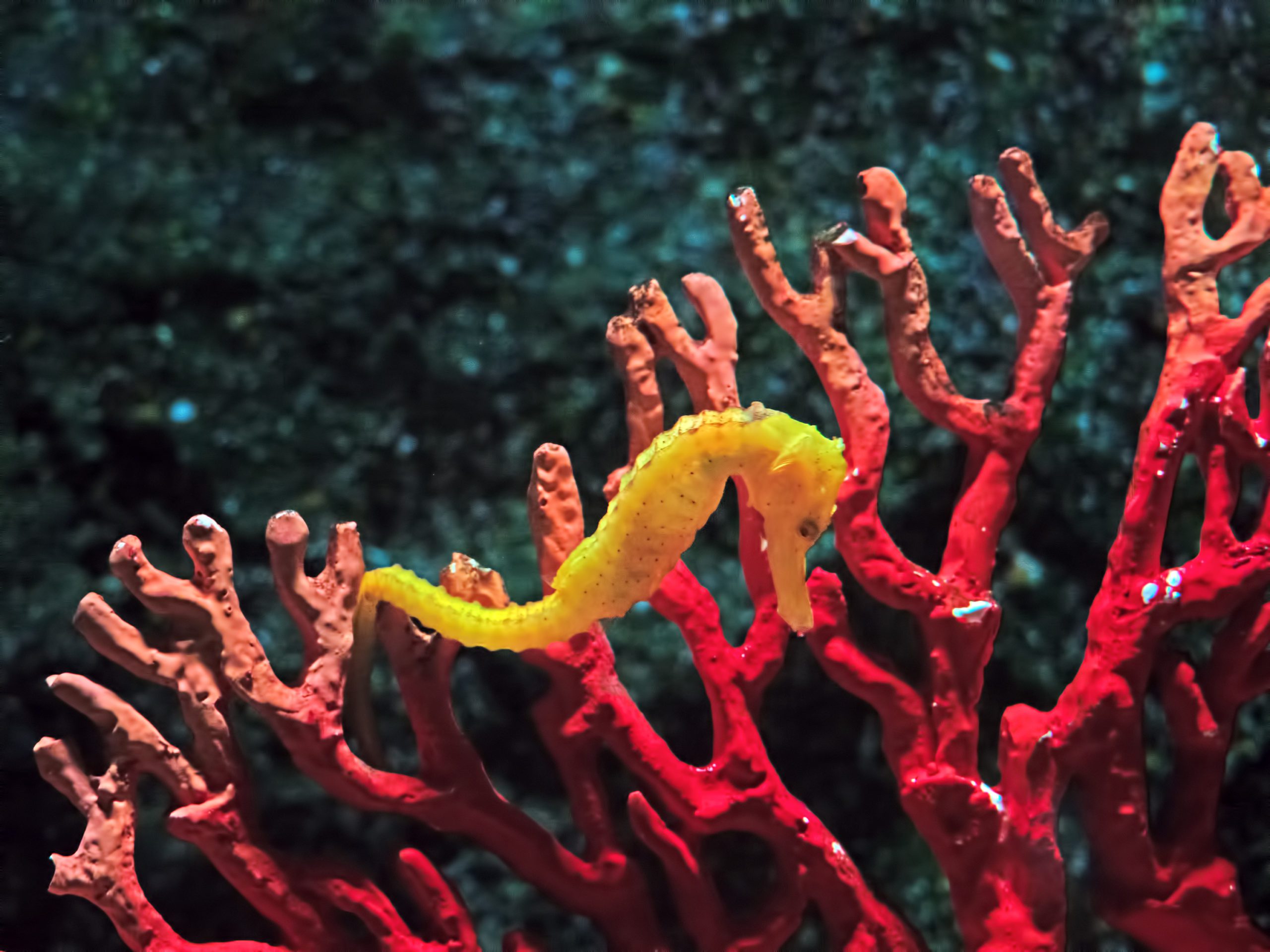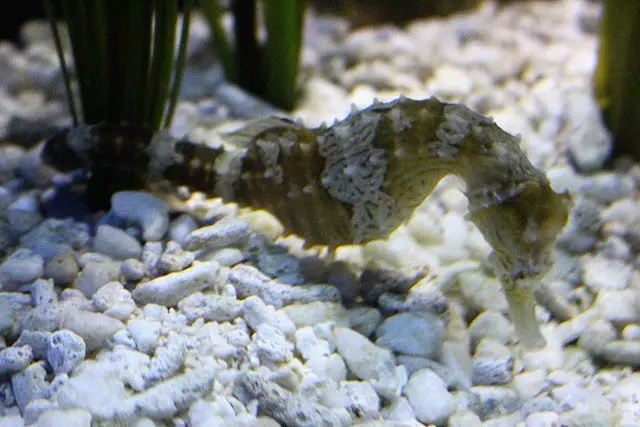Half-Spined Seahorse, Captive-Bred
$147.99
Select Variant
Hippocampus semispinosus is commonly referred to as the Half-spined Seahorses, naturally occurs within the Timor Sea from N.W. Australia up to Bali which is where they like the muddy substrate habitats found in and close proximity to mangroves.
Female and male Half-spined Seahorses can differ in their color. Males vary in hues ranging from dark brown to yellow with white flecks in their trunks. Females' colors can vary from dark red to yellow. When in the wild seahorses might also be covered in algae on their spines. Similar to all seahorses, males have their babies in their pouches.
They thrive when they are kept as an mated pair or small groups in a single species aquarium. A 30-gallon aquarium is adequate for just one pair. You can add 10 gallons to the size of the aquarium to accommodate each pair. Spray bars can be utilized to provide a gentle flow, as well as eliminate stagnant areas from the aquarium. Seahorses aren't very strong swimmers and prefer to utilize their prehensile tails connect to branches of live rock algae, artificial decorations.
Seahorses are less prone to contract Vibrio bacteria-related infections if temperature isn't permitted to rise above 74 degrees F. This is crucial in the case of aquariums that contain different species of Syngnathids. It is also essential to get rid of waste and leftover food every day. The levels of calcium and alkalinity must be checked and maintained in order to ensure that their bone plates remain well-maintained.
Half-spined Seahorses are often kept alongside small, timid fish like small gobies, pipefishand dragonets, and firefish. However, territorial, aggressive or fast-moving fish will not work well with half-spined Seahorses.
Seahorses are susceptible to injury from anemones, corals with tentacles that sting, or corals that can be large enough to devour them, like brain corals. Although ocean fans Acropora corals as well as other branching corals are suitable for seahorses, corals may be inflamed and damaged due to a seahorse that constantly tacks on them. Crabs and clams could prick the seahorse, causing a cut which could cause secondary infections. Small ornamental crustaceans can be consumed by seahorses.
Beware of fish that compete with Half-spined Seahorses in search of food. The captive-bred seahorses are used to eating frozen Mysis shrimp, which makes them an ideal alternative to wild-caught species. They also feed on amphipods, as well as other small crustaceans that live in rock. Half-spined Seahorses can also take adult brine shrimp with vitamin enrichment however, this shouldn't comprise a large portion part of the diet. They are slow deliberate feeders, and they are more likely to have two or three small meals a day.
Seahorses are perhaps the most well-known fish around because of their unique appearance and behavior. They are extremely social, curious fish that are enjoyable to watch as you watch them interact with your environment as well as with each other and even with their owners.
Approximate Size of Purchase: Small: 1" to 2"; Medium: 2" to 3", Large: 3" to 4".
- Description
- Additional Information
- Reviews
Half-Spined Seahorse, Captive-Bred Information
Hippocampus semispinosus is commonly referred to as Half-spined seahorses, is a natural phenomenon throughout the Timor Sea from N.W. Australia up to Bali in the area where they are averse to sandy substrates and habitats surrounding mangroves.
Male and female Half-spined Seahorses can differ in their color. Males may vary in hues ranging from yellow-brown to dark brown, with white splashes on their trunks. Females may vary in color between dark red and yellow. When in the wild seahorses might also be spotted with algae growing on their spines. As with all seahorses, males give birth to seahorses within their pouches.
The social fish thrive when they are kept in a mated pair or small groups in an exclusive species aquarium. A 30-gallon aquarium is adequate for just one pair. You can add 10 gallons to the size of the aquarium to accommodate each pair. Spray bars can be used to provide a gentle flow, as well as eliminate stagnant areas from the aquarium. Seahorses aren't very strong swimmers and prefer to make use of their prehensile tails to connect to branches of live rock algae, artificial decorations.
Seahorses are less prone to contract Vibrio bacteria infections if the temperature isn't allowed to go over 74 degrees Fahrenheit. This is especially important in the case of aquariums that contain other Syngnathid species. It is also important to eliminate waste and food every day. Alkalinity and calcium levels need to be checked and maintained in the order in order to keep their bony plates well-maintained.
Half-spined Seahorses are often kept alongside small, shy fish like tiny gobies, pipefish dragonets, and firefish. However aggressive, territorial, or fast-moving fish will not make great companions.
Seahorses may be injured by anemones, corals with tentacles that sting, or corals that have enough size to devour them, like brain corals. Although sea fan, Acropora corals, and various branching corals are safe for seahorses. However, the corals may be inflamed and damaged due to a seahorse that constantly tacks on them. Crabs and clams could prick the seahorse, causing a cut which could cause secondary infections. Small ornamental crustaceans could be eaten by seahorses.
Beware of fish that compete with Half-spined Seahorses in search of food. The captive-bred seahorses are used to eating frozen Mysis shrimp, which makes an excellent alternative to wild-caught species. They also feed on amphipods as well as other crustaceans in live rock. Half-spined Seahorses can also take adult brine shrimp with vitamin enrichment but it shouldn't constitute a large portion part of the diet. They are slow deliberate feeders, and they like two or more small meals a day.
Seahorses are perhaps the most famous fish around due to their distinctive appearance and behavior. They are very social and curious fish that are enjoyable to observe as you watch them interact with your environment including each other, and even with their owners.
size
Large, Medium, Small
Units
1
Weight
6 lbs
Dimensions
1 × 1 × 1 in














Reviews
There are no reviews yet.